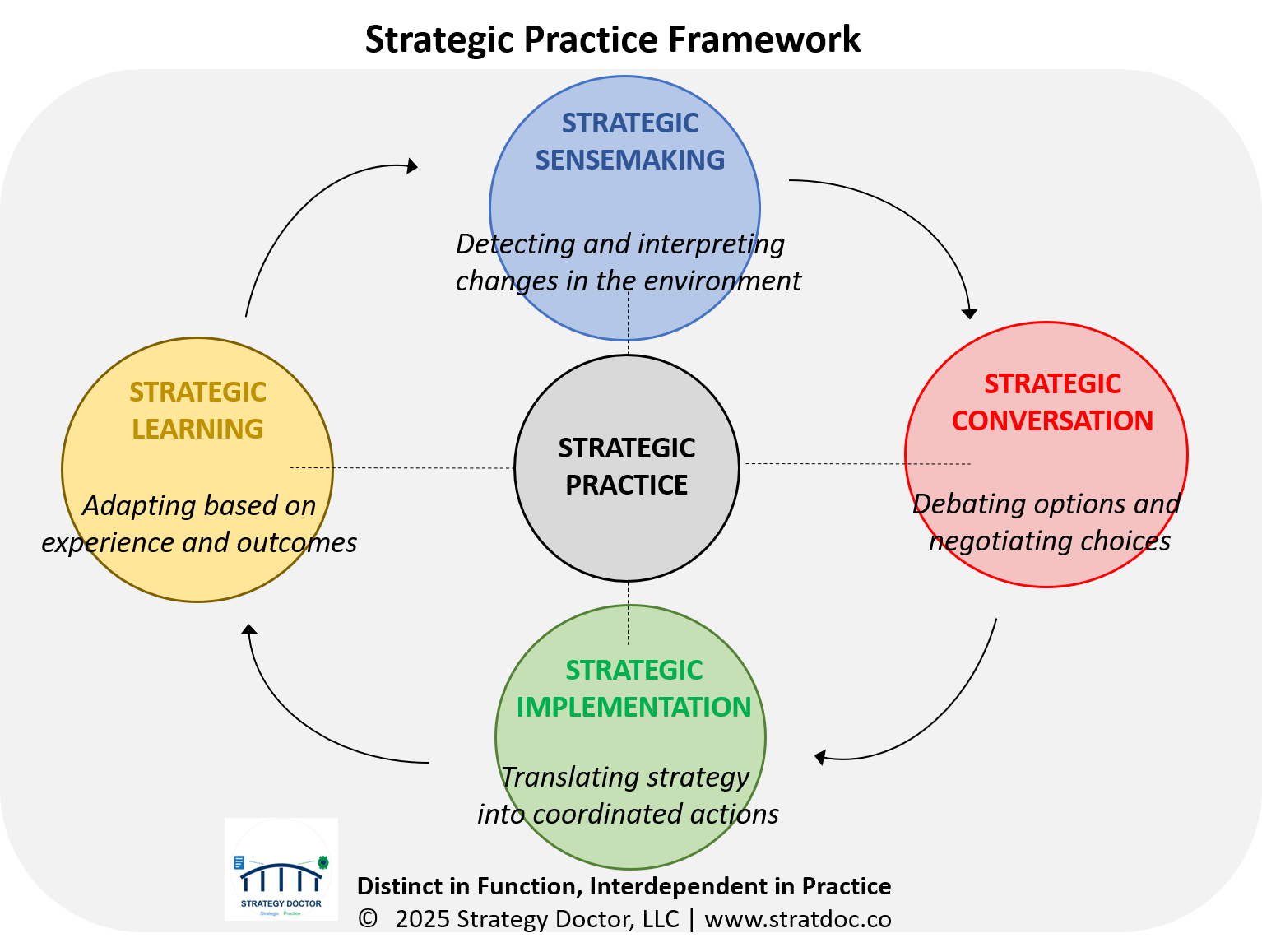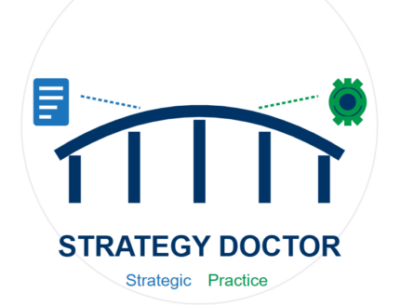Executive Summary: Most organizations face a critical gap between strategic planning and execution, with 60-90% of strategies failing to deliver intended results. The solution isn’t better planning—it’s developing robust strategic practices that connect thinking to action and build organizational capacity for strategic agility in uncertain environments.
In my previous blog, I explored how practice theory offers a powerful framework for understanding leadership in complex organizations. Today, I would like to extend this conversation to examine how the practice lens transforms our understanding of strategy itself—moving us beyond documents and PowerPoints to the messy, dynamic world of “strategic doing” while building organizational capacity for an uncertain future.
Beyond the Strategic Planning Fallacy
Most organizations approach strategy as an episodic exercise—an annual retreat where executives gather to develop a 3-5 year plan that promptly gets filed away until the next planning cycle. This approach, rooted in the classical view of strategy, treats strategy as a product rather than a process. It assumes the future can be predicted with reasonable certainty and that organizations can successfully implement predetermined plans in dynamic environments.
Research consistently shows that between 60% and 90% of strategies fail to deliver their intended results. My experience working with organizations across multiple sectors—from global corporations like SAP to military operations and entrepreneurial ventures—confirms this sobering reality. The problem isn’t usually a bad strategy; it’s the gap between strategy as conceived and strategy as practiced.

The problem isn’t usually bad strategy; it’s the gap between strategy as conceived and strategy as practiced.
This gap exists not because organizations lack discipline or commitment, but because we’ve inherited a flawed model of how strategy works. Traditional approaches treat strategy formulation and implementation as separate, sequential activities—first we plan, then we execute. This separation creates a fundamental disconnect between those who design strategy and those tasked with implementing it.
Strategy as Everyday Practice
When we view strategy through a practice lens, we see something quite different. Strategy becomes not just something organizations have but something people do. This perspective shifts our focus from the formal strategic plan to the everyday activities, conversations, decisions, and interactions that collectively constitute an organization’s strategic direction.
As someone who has navigated corporate transformations, startup ventures, military operations, and academic research, I’ve observed that successful strategy emerges from four interconnected domains of practice:

- Strategic Sensemaking Practices: How organizational members collectively interpret their environment and identify strategic issues. These include market scanning, customer insight sessions, competitive intelligence gathering, and the narratives organizations construct about their place in the world. Organizations with superior sensemaking practices detect meaningful changes earlier and interpret them more accurately than competitors.
- Strategic Conversation Practices: The forums and interactions where strategic options are debated, priorities negotiated, and resources allocated. These include not just formal strategy meetings but the everyday conversations where strategy is interpreted, translated, and adapted. The quality of these conversation practices determines how effectively organizations translate environmental insights into strategic choices.
- Strategic Implementation Practices: The day-to-day activities through which strategy is enacted—how middle managers translate strategic intent into operational priorities, how resources are deployed and reallocated as circumstances change, and how organizations learn and adapt through execution. These practices form the critical bridge between strategic intent and organizational outcomes.
- Strategic Learning Practices: The mechanisms through which organizations extract insights from experience and adjust approaches accordingly. These include experimentation practices that promote small-scale tests of strategic options, reflection practices that derive lessons from both successes and failures, and knowledge-sharing practices that disseminate learning throughout the organization.
The Board’s Role in Strategic Practice
Boards play a crucial role in shaping an organization’s strategic practices, yet many operate with outdated models of strategy governance. In my work advising boards across various sectors, I’ve found that high-performing boards move beyond simply approving strategic plans to actively strengthening the organization’s strategic practices.

Effective boards contribute to strategic practices in several key ways:
- Enriching strategic sensemaking: Board members bring diverse external perspectives that can help organizations detect emerging threats and opportunities. Rather than limiting their contribution to quarterly reviews, effective board members engage in ongoing strategic dialogue that challenges executive assumptions and broadens organizational perception.
- Elevating strategic conversation: Boards can enhance the quality of strategic dialogue by asking probing questions that challenge conventional thinking and broaden the range of options considered. By focusing discussion on critical strategic uncertainties rather than operational details, boards help organizations develop more robust strategic approaches.
- Enabling strategic agility: Rather than forcing executives to commit firmly to detailed long-term plans, forward-thinking boards embrace strategic frameworks that allow for adaptation as conditions change. They approve decision rules and boundary conditions that provide strategic clarity while enabling operational flexibility.
- Embedding strategic learning: Effective boards establish expectations and mechanisms for systematic learning from strategy implementation. They review not just performance outcomes but also the quality of the organization’s learning process, encouraging experimentation and thoughtful adaptation rather than rigid adherence to plans.
Boards that master these practices become valuable strategic partners rather than mere plan approvers or compliance monitors. They help organizations develop the strategic capacity needed to navigate today’s complex business environment.
“Boards that master strategic practices become valuable strategic partners rather than mere plan approvers or compliance monitors.”
Building Strategic Capacity for Uncertain Times
Traditional strategic planning approaches were designed for a world of relative stability and predictability. They falter in today’s complex and dynamic business landscape, where strategic success depends less on perfect planning and more on building organizational capacity for strategic agility —the ability to sense emerging challenges and opportunities quickly and respond effectively.
Organizations seeking to close the strategy-execution gap and develop strategic agility need to focus on the practices that connect strategic intent with daily action. Based on my research and consulting experience, I recommend starting with an honest assessment of your organization’s current practices:
- How do you currently detect and interpret changes in your environment? Are these activities systematic or ad hoc? Who participates?
- How do strategic conversations happen in your organization? What perspectives are included or excluded? How are disagreements handled?
- How are broad strategic objectives translated into specific actions at different organizational levels? Do you have mechanisms to ensure alignment?
- How easily can you reallocate resources as priorities shift? What formal or informal barriers exist?
- How effectively do you learn from experience? Do you have mechanisms in place to capture insights and adjust your approaches accordingly?
The Practice Advantage
Organizations that excel in strategic execution understand that strategy is embedded in these everyday practices. They recognize that strategic advantages come not just from having the right plan but from cultivating distinctive organizational practices that competitors cannot easily imitate.
Consider how Apple’s strategy is embedded in its design practices, Amazon’s in its customer obsession practices, and Toyota’s in its continuous improvement practices. These organizations don’t just have strategies—they do strategy differently.
In an increasingly volatile and complex business environment, these strategic practices may be your most valuable competitive asset. By strengthening these practice domains, you can build an organization that not only has a strategy but also strategizes effectively in the face of uncertainty.
A New Approach to Strategy Consulting
Unlike traditional strategy consultants who deliver static plans and frameworks, Strategy Doctor builds your organization’s strategic muscle through practice development—creating sustainable capacity for strategic agility that persists long after our engagement ends.
My work with clients through Strategy Doctor focuses on this practice-based approach to strategy. Rather than delivering standard strategic analysis and recommendations, I help organizations develop their distinctive strategic practices—the ways they collectively think about, talk about, decide about, and learn about strategy.
Even organizations with well-established strategic planning processes can integrate these practices without disruption, typically starting with a single domain, such as strategic conversations or learning practices, before expanding to a comprehensive approach.
This approach includes:
- Diagnostic assessment of current strategic practices
- Practice design that creates new organizational routines for sensing and responding
- Leadership development focused on facilitating strategic practices across the organization
- Board advisory services that enhance strategic governance
- Implementation coaching that helps embed new practices in daily organizational life
This approach recognizes that sustainable strategic advantage comes not just from having the right plan but from having superior practices for developing and executing strategy over time—practices that become embedded in your organization’s DNA and can’t be easily copied by competitors.
Strategic success isn’t a destination but an ongoing journey—one that requires thoughtful attention to the organizational practices that enable collective strategic capacity.
Dr. Mohamed Amer is a strategy advisor with over 25 years of experience spanning military leadership, global corporate roles, entrepreneurial ventures, and academic research. As a Certified Chair™ Executive, RetailWire BrainTrust panelist, and Top Retail Expert, he brings a uniquely integrated perspective to strategic challenges. With a Ph.D. in Human and Organizational Systems and executive experience at SAP, he bridges rigorous academic insights with practical business applications.
Ready to strengthen your organization’s strategic practices? Schedule a 30-minute Strategic Practice Assessment to evaluate your current capabilities and identify areas for improvement.
This blog draws on research developed through my academic exploration of practice theory and strategic management, combined with decades of experience guiding organizations through strategic transformations. Strategy Doctor provides advisory services that incorporate these cutting-edge perspectives for organizations seeking to develop more effective strategies in complex environments. Visit StratDoc.co to learn more.


Great points Mohamed, strategy is ever more important in these critical times and we need new ideas and playbooks to strategize for the future.